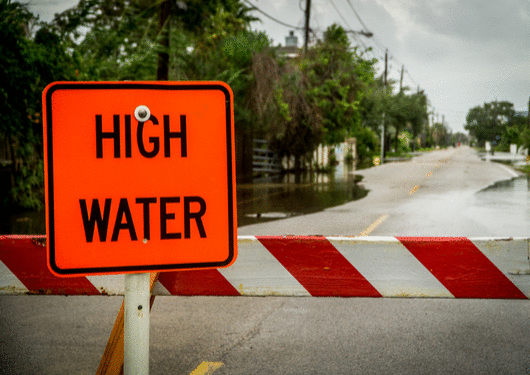
Think Tank
Building Resilient Supply Chains Across a Volatile Business Landscape

The 2019 edition of DHL’s Resilience360 report projected that this year, businesses should prepare for at least four major hurricanes across the Americas and 10 typhoons in East Asia. In addition to Hurricane Dorian’s very recent assault on the Bahamas and the U.S. East Coast, one needs look no further than last year’s storms — such as Hurricane Florence, which led to 54 deaths in the U.S. and caused an estimated $24.23 billion in damages — to grasp the massive destruction left in their respective wakes.
Logistics companies have long known that these natural disasters can have a huge impact on their ability to move goods around the world. However, businesses’ ability to operate efficiently can be impacted by more than just weather events. Today’s volatile business landscape is punctuated by changes in fuel pricing, tariffs, new regulations, and more. Each of these factors presents a legitimate threat to organizations’ efficient operation of their supply chains, which can heavily impact the bottom line.
Understandably, today’s global organizations are eager for practical guidance on building resilient supply chains amidst this mounting volatility. A key element is the ability to manage risk, which requires visibility and control over all aspects of the supply chain. To achieve this goal, supply-chain managers must connect, sync and track manufacturers, distributors, suppliers, customers, logistics organizations and all of the systems serving each ecosystem stakeholder. This “all data” (as opposed to “some data”) approach delivers a holistic “ecosystem” view of the business, and leads to optimized transportation routes, employee efficiency, less inventory, lower freight costs and greater visibility into buying patterns.
A typical business ecosystem consists not only of the company and its partners, customers, suppliers and vendors, but also B2B and B2C technologies used by the company and its third parties. By viewing this complex tangle of stakeholders as a business ecosystem and looking at the integration boundaries between members, an organization can gain insight into its end-to-end business processes to better understand how critical trading-partner relationships are performing — and more importantly, how they can be improved.
The truth is that many organizations’ supply chains are not currently equipped to support the ecosystem approach, and these companies therefore need to transform their operations and IT infrastructure to ensure they build resiliency into the core of their business. This is true of the infrastructure from both an internal and external perspective, with the latter supporting the organization’s customer and partner activities.
The question then becomes, how can these organizations identify gaps and shortcomings in their existing infrastructure, and how can they address these gaps before they become an ongoing liability? This is best done by analyzing and evaluating end-to-end processes so the IT department can view the business from the outside-in — focusing on the core external ecosystem integrations that drive value, and tracing these through to internal systems.
In order to ensure that their supply chains can withstand market shifts, there are several critical upgrades organizations must make to their business processes and IT infrastructure. These include the following:
- Move EDI service to a stable platform. More than just stable, it needs to be robust and flexible. A potentially volatile and rapidly shifting supply chain means that organizations must be able to react swiftly. And that means being able to quickly integrate with new trading partners and modify existing supply-chain relationships.
- Eliminate non-integrated, unsecured data practices. Reliance on legacy manual processes can significantly limit the agility of an organization. As well as being error-prone, such processes can be stretched to a breaking point when there is disruption in the supply chain. A flexible integration framework can eliminate these risks and challenges.
- Expedite the time it takes to set up new customers and partners. In a dynamically changing environment, time is of the essence in reacting to it. Being able to respond rapidly to changes in the business ecosystem and set up new partners, customers and suppliers quickly is essential to maintaining business and even capitalizing on disruption.
- Automate integration with enterprise resource planning. For most organizations, the ERP is the core of the business, with tentacles that extend to partner, supplier and customer interactions as well as to other internal systems. Wherever possible, automating the business processes by integrating the ERP with other systems will provide the solid backbone to the business and the resilience needed to respond to disruptions.
- Lay the groundwork for future application integration and API development to open the business to software-as-a-service (SaaS) technology. Preferred methods for integration are constantly evolving, and while EDI is still the core of many ecosystem interactions in the supply chain, more and more modern processes and SaaS platforms are using APIs for integration. Being ahead of the game with API and application integration tooling will allow organizations to take advantage of new opportunities quickly, rapidly adopt value-added services as they appear, and not be limited by technology.
- Consolidate vendors to reduce overlaps and encourage economies of scale. Many supply-chain organizations’ systems are still held together with string and duct tape. Taking a consolidated view, and choosing tooling that can provide an integrated platform, can not only improve resilience, but also reduce the operational costs of maintaining multiple skill sets within the organization. In addition, a common platform can provide core insights because of the common data visibility it can provide.
Given the increasing volatility across today’s global business landscape, it is imperative that organizations make significant strides in building resiliency into their supply chains. While extreme weather events make it painfully clear when an organization’s supply chain isn’t suitably resilient, companies would be wise to prepare for all threats to the ongoing operation of their global supply chains.
By examining and addressing the needs of the supporting business and IT infrastructure, organizations will be able to ensure that their supply chains are built to survive and thrive in today’s highly turbulent business environment.
Dave Brunswick is vice president of solutions with Cleo, a provider of logistics and supply-chain management services.






